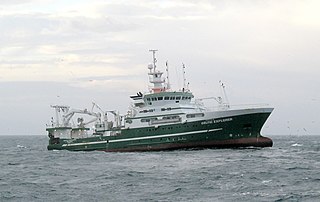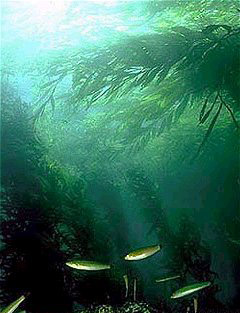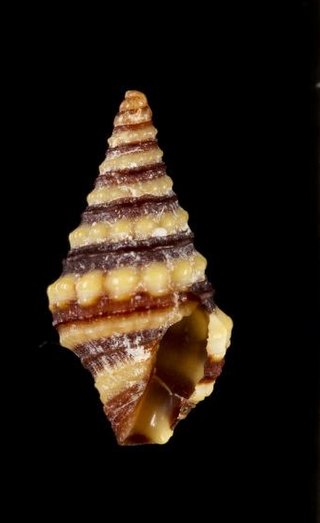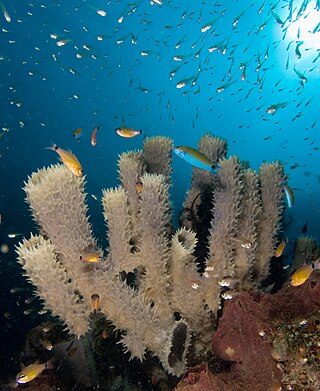
A biogeographic realm is the broadest biogeographic division of Earth's land surface, based on distributional patterns of terrestrial organisms. They are subdivided into bioregions, which are further subdivided into ecoregions. A biographic realm is also known as "ecozone", although that term may also refer to ecoregions.

The benthic zone is the ecological region at the lowest level of a body of water such as an ocean, lake, or stream, including the sediment surface and some sub-surface layers. The name comes from ancient Greek, βένθος (bénthos), meaning "the depths." Organisms living in this zone are called benthos and include microorganisms as well as larger invertebrates, such as crustaceans and polychaetes. Organisms here generally live in close relationship with the substrate and many are permanently attached to the bottom. The benthic boundary layer, which includes the bottom layer of water and the uppermost layer of sediment directly influenced by the overlying water, is an integral part of the benthic zone, as it greatly influences the biological activity that takes place there. Examples of contact soil layers include sand bottoms, rocky outcrops, coral, and bay mud.

Bottom trawling is trawling along the seafloor. It is also referred to as "dragging". The scientific community divides bottom trawling into benthic trawling and demersal trawling. Benthic trawling is towing a net at the very bottom of the ocean and demersal trawling is towing a net just above the benthic zone. Bottom trawling can be contrasted with midwater trawling, where a net is towed higher in the water column. Midwater trawling catches pelagic fish such as anchovies and mackerel, whereas bottom trawling targets both bottom-living fish (groundfish) and semi-pelagic species such as cod, squid, shrimp, and rockfish.

Kelp forests are underwater areas with a high density of kelp, which covers a large part of the world's coastlines. Smaller areas of anchored kelp are called kelp beds. They are recognized as one of the most productive and dynamic ecosystems on Earth. Although algal kelp forest combined with coral reefs only cover 0.1% of Earth's total surface, they account for 0.9% of global primary productivity. Kelp forests occur worldwide throughout temperate and polar coastal oceans. In 2007, kelp forests were also discovered in tropical waters near Ecuador.

The seabed is the bottom of the ocean. All floors of the ocean are known as 'seabeds'.
The abyssal zone or abyssopelagic zone is a layer of the pelagic zone of the ocean. The word abyss comes from the Greek word ἄβυσσος (ábussos), meaning "bottomless". At depths of 4,000–6,000 m (13,000–20,000 ft), this zone remains in perpetual darkness. It covers 83% of the total area of the ocean and 60% of Earth's surface. The abyssal zone has temperatures around 2–3 °C (36–37 °F) through the large majority of its mass. The water pressure can reach up to 76 MPa.
A marine ecoregion is an ecoregion, or ecological region, of the oceans and seas identified and defined based on biogeographic characteristics.

Pelagic fish live in the pelagic zone of ocean or lake waters—being neither close to the bottom nor near the shore—in contrast with demersal fish that do live on or near the bottom, and reef fish that are associated with coral reefs.

Demersal fish, also known as groundfish, live and feed on or near the bottom of seas or lakes. They occupy the sea floors and lake beds, which usually consist of mud, sand, gravel or rocks. In coastal waters they are found on or near the continental shelf, and in deep waters they are found on or near the continental slope or along the continental rise. They are not generally found in the deepest waters, such as abyssal depths or on the abyssal plain, but they can be found around seamounts and islands. The word demersal comes from the Latin demergere, which means to sink.

Marine sediment, or ocean sediment, or seafloor sediment, are deposits of insoluble particles that have accumulated on the seafloor. These particles have their origins in soil and rocks and have been transported from the land to the sea, mainly by rivers but also by dust carried by wind and by the flow of glaciers into the sea. Additional deposits come from marine organisms and chemical precipitation in seawater, as well as from underwater volcanoes and meteorite debris.

The Gobiiformes are an order of fish that includes the gobies and their relatives. The order, which was previously considered a suborder of Perciformes, is made up of about 2,211 species that are divided between seven families. Phylogenetic relationships of the Gobiiformes have been elucidated using molecular data. Gobiiforms are primarily small species that live in marine water, but roughly 10% of these species inhabit fresh water. This order is composed chiefly of benthic or burrowing species; like many other benthic fishes, most gobiiforms do not have a gas bladder or any other means of controlling their buoyancy in water, so they must spend most of their time on or near the bottom. Gobiiformes means "goby-like".

The Central Eastern Shelf Province is a biogeographic region of Australia's coastal and continental shelf waters. It includes the warm temperate coastal waters of eastern Australia. It is a provincial level bioregion in the Integrated Marine and Coastal Regionalisation of Australia (IMCRA) system. It corresponds to the Manning-Hawkesbury marine ecoregion in the WWF's Marine Ecoregions of the World system.

Tweed–Moreton, also known as the Central Eastern Shelf Transition, is a marine biogeographic region of eastern Australia.

The Tasmanian Shelf Province is a biogeographic region of Tasmania's coastal and continental shelf waters. It covers the western, eastern, and southern coasts of Tasmania. It is a provincial level bioregion in the Integrated Marine and Coastal Regionalisation of Australia (IMCRA) system. The Tasmanian Shelf and adjacent Bass Strait Shelf provinces correspond to the Bassian marine ecoregion in the WWF's Marine Ecoregions of the World system.

Arvoredo Marine Biological Reserve is a Biological reserve off the coast of the Santa Catarina state, Brazil.

The western school whiting, also known as the banded whiting, golden whiting and bastard whiting, is a species of benthic marine fish in the smelt-whiting family Sillaginidae. The species is one of three 'school whiting' that inhabit southern Australia and share a very similar appearance. Western school whiting are known to grow to 30 cm in length and 275 g in weight, although unconfirmed reports suggest this might be an underestimate. The western school whiting is distributed along the Western Australian coast from Maud Landing in the north to Rottnest Island in the south. The species inhabits both shallow inshore environments and waters to depths of 55 m. The species is a benthic predator, taking a variety of crustaceans, molluscs and echinoderms, and shows a change in diet with age and habitat. S. vittata is a multiple spawner, reproducing between December and February once it has reached one or two years of age. Juveniles inhabit protected inshore waters, moving offshore once they reach sexual maturity. It is often found in association with other sillaginids and comprises a minor fraction of commercial whiting catches in Western Australia.
The Southern Pacific Gyre is part of the Earth's system of rotating ocean currents, bounded by the Equator to the north, Australia to the west, the Antarctic Circumpolar Current to the south, and South America to the east. The center of the South Pacific Gyre is the oceanic pole of inaccessibility, the site on Earth farthest from any continents and productive ocean regions and is regarded as Earth's largest oceanic desert. With an area of 37 million square kilometres it makes up ~10 % of the Earth's ocean surface. The gyre, as with Earth's other four gyres, contains an area with elevated concentrations of pelagic plastics, chemical sludge, and other debris known as the South Pacific garbage patch.

Pilsbryspira albocincta, common name the white-banded turret, is a species of sea snail, a marine gastropod mollusk in the family Pseudomelatomidae, the turrids.

Marine habitats are habitats that support marine life. Marine life depends in some way on the saltwater that is in the sea. A habitat is an ecological or environmental area inhabited by one or more living species. The marine environment supports many kinds of these habitats. Marine habitats can be divided into coastal and open ocean habitats. Coastal habitats are found in the area that extends from as far as the tide comes in on the shoreline out to the edge of the continental shelf. Most marine life is found in coastal habitats, even though the shelf area occupies only seven percent of the total ocean area. Open ocean habitats are found in the deep ocean beyond the edge of the continental shelf.

The marine ecoregions of the South African exclusive economic zone are a set of geographically delineated regions of similar ecological characteristics on a fairly broad scale, covering the exclusive economic zone along the South African coast.
















